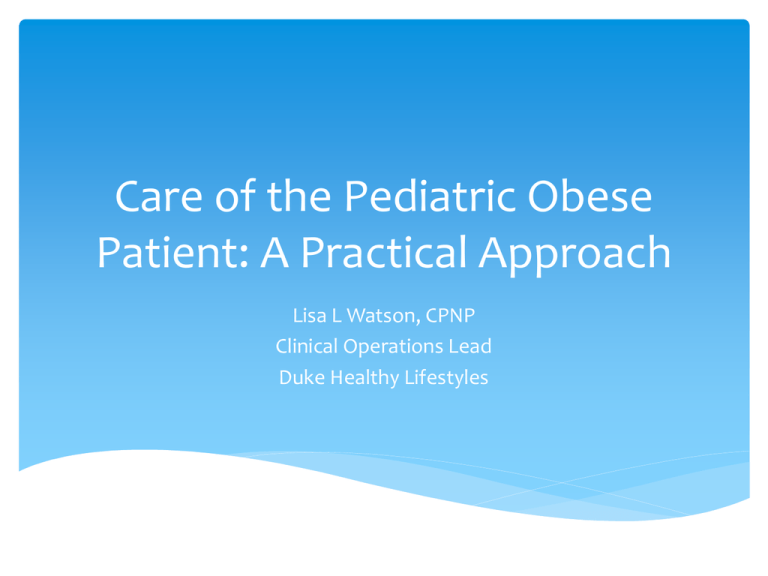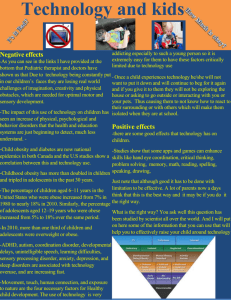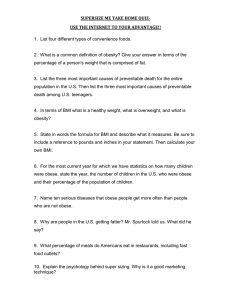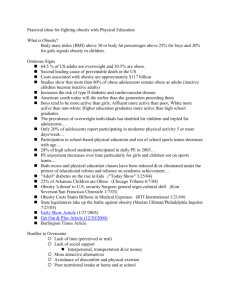Care of the Obese Pediatric Patient
advertisement

Care of the Pediatric Obese Patient: A Practical Approach Lisa L Watson, CPNP Clinical Operations Lead Duke Healthy Lifestyles Financial Disclosures I have no financial disclosures (unfortunately)… By the end of this talk, I hope you… See obesity for what it is – a sign of what’s really going on Treat obesity as a chronic illness that requires followup and ongoing changes in treatment Realize that confrontational measures often backfire Have an increased appreciation for how hard it is to lose weight Come away with at least one concrete way you can help these kids Why Should We Care Retrieved from http://www.mozartinshape.org/misvsobesity/whymis.php?id=ch02 on October 17, 2013 Obese kids have similar quality of life scores as kids with cancer… JAMA. 2003 Apr 9;289(14):1813-9. Health-related quality of life of severely obese children and adolescents. Results: Compared with healthy children and adolescents, obese children and adolescents reported significantly (P<.001) lower health-related QOL in all domains (mean [SD] total score, 67 [16.3] for obese children and adolescents; 83 [14.8] for healthy children and adolescents). Obese children and adolescents were more likely to have impaired health-related QOL than healthy children and adolescents (odds ratio [OR], 5.5; 95% confidence interval [CI], 3.4-8.7) and were similar to children and adolescents diagnosed as having cancer (OR, 1.3; 95% CI, 0.8-2.3). Children and adolescents with obstructive sleep apnea reported a significantly lower health-related QOL total score (mean [SD], 53.8 [13.3]) than obese children and adolescents without obstructive sleep apnea (mean [SD], 67.9 [16.2]). For parent proxy report, the child or adolescent's BMI z score was significantly inversely correlated with total score (r = 0.246; P =.01), physical functioning (r = -0.263; P<.01), social functioning (r = -0.347; P<.001), and psychosocial functioning (r = -0.209; P =.03). Epidemic within an epidemic Childhood obesity has more than doubled in the past 30 years. By comparison, the proportion of children classified as “severely obese” has tripled. Currently 4% of all children fall in this category. By 2030, overall obesity in the US is expected to increase by 31% while severe obesity is expected to increase by 130%. Ogden CL et al. Journal of the American Medical Association 2014;311(8):806-814. National Center for Health Statistics. Health, United States, 2011: U.S. Department of HHS; 2012. National Institutes of NHLBI, 2010. IOM, Dietz W et al, Roundtable on Childhood Obesity, 2014. Skelton et al, Archives, 2009. Finkelstein E, American Journal of Preventative Medicine, 2012. Why is this SO Hard? This isn’t rocket science….. ……it’s harder Why is this SOOOO Hard? Retrieved from: https://www.google.com/search?q=metabolic+pathways&espv=2&biw=1204&bih=631&source=lnms&tbm=isch&sa=X&ved=0CAYQ_AUoAWoVChMIzOHo-ccyAIVg5qACh34SQsh&dpr=1#imgrc=wNHhoHn8yZWQGM%3A, September 29, 2015. A Calorie is NOT a Calorie Continued misconception: Food intake – Energy expenditure = Net weight gain Example Multiple systems regulate weight Hormonal Control a) Adipokines b) Gastrointestinal peptides Neural Control a) Homeostatic system (metabolic brain) b) Hedonic system (emotional brain) c) Cognitive brain Environmental Control a) Stress b) Circadian rhythm c) Thermoregulation and BAT d) Microbiota e) Infection Berthoud et al, Physiology, 2008, 23 75-83 Adipose Tissue IS an Organ Old Definition: An inert tissue “Adipose tissue, or fat, is an anatomical term for loose connective tissue composed of adipocytes. Its main role is to store energy in the form of fat, although it also cushions and insulates the body.” -Google Adipose Tissue IS an Organ New Definition: A dynamic metabolic organ Adipose tissue, or fat, is a dynamic and varied endocrine organ comprised of several cell types. Its physiology and functions are, in part, distribution-dependent. A complex interplay of neurohormonal factors determines its synthesis, breakdown, and storage. Ahmed, N. (2015). Pathophysiology of Obesity, Blackburn Course in Obesity Medicine The Adipocyte: An Endocrine Factory Over 600 adipokines have been identified! Retrieved from https://www.google.com/search?q=adipose+tissue&es_sm=93&source=lnms&tbm=isch&sa=X&ved=0CAcQ_AUoAWoVChMI3MuqlZGgyAIVBpACh26Iwvh&biw=1204&bih=631#imgdii=fLywxRLs6Eo33M%3A%3BfLywxRLs6Eo33M%3A%3Bup7D8Hkg30_eAM%3A&imgrc=fLywxRLs6Eo33M%3A, September 30, 2015. So Now We’re Here…Now What? Step 1: Broach the topic of obesity with the family Step 2: Find out what’s important to the patient (it’s usually NOT their health) Step 3: Take a lifestyle history Step 4: Check for Comorbidities Step 5: Treat Comorbididities and use motiviational interviewing to encourage lifestyle/behavioral change Step 6: Manage expectations, keep engaged, reevaluate, refer STEP 1 How to Breach the Topic of Obesity with the Patient and Family Talking About BMI BMI: weight (kg) / [height (m)]2 Talk about it as a way of predicting future health, not weight. (ie “The BMI is your health number.”) Predicts risk of future heart disease, diabetes, etc. Think of it like a stop light Refer to the child’s BMI as a zone (green zone, yellow zone, red zone) AVOID language like healthy weight, overweight, obese Don’t necessarily want to lose weight. May just need to stabilize rate of weight gain. Remind them it’s not all about the numbers Retrieved from http://prowellness.vmhost.psu.edu/prevention/understanding_risk/ bmi on November 2, 2013 Step 2: Find out what’s important to your patient What would be better or easier if you lost weight? If you can make one thing in your life better, what would it be? Sports Clothes Friends Feeling better Less teasing Step 3: Take a lifestyle history 5 vegetables and fruits 3 meals a day 2 no more than 2 hours of screen time 1 hour of daily activity Almost none of the sugary stuff Sleep Eating behaviors (eating quickly, second helpings, what does it feel like when they’re full, food sneaking/seeking behaviors) STEP 4: Rule Out Comorbidities Insulin Resistance (prediabetes)/Diabetes Heart Disease Nonalcoholic Fatty Liver Disease (NAFLD) Kidney Disease Musculoskeletal Abnormalities Endocrine Abnormalities Reproductive issues Psychological Disorders Genetic Causes Tests to Consider Blood Pressure Screen: Check 2 BPs with each visit (use average of the two) If high, double check manually Diabetes Screen: Fasting glucose, insulin, HgbA1c Cholesterol Screen: Fasting lipid panel with calculated LDL HS CRP NAFLD Screen: ALT, AST Thyroid Screen: TSH Other Screens: Uric Acid 25-OH Vit D Urine Microalbumin Insulin Resistance / Type 2 Diabetes Fasting Labs: Glucose: >100 or Insulin >17 A1c: 5.7-6.4 insulin resistance A1c 6.5 or > is T2DM Look for acanthosis in nuchal folds, axilla, groin How to treat IRS For all levels of insulin resistance: Decrease CHO Increase protein (EVERYTIME they eat they need a protein) Increase exercise Consider low carbohydrate diet A1c >6% - treat with metformin to prevent progression to T2DM Start metformin 500mg PO with dinner x 1 week. If tolerating well, increase to 1000mg daily. May go as high as 2 grams daily Refer to Healthy Lifestyles A1c > 6.5% - still start metformin, add BID glucose checks and endocrine referral (page them), and refer to Healthy Lifestyles Start metformin 500mg PO with dinner x 1 week. If tolerating well, increase to 1000mg daily. May go as high as 2 grams daily Heart Disease Fasting lipid panel with calculated LDL: Total Cholesterol < 170 LDL < 130 HDL > 40 (ideally > 60) Triglycerides < 110 High Sensitivity C-Reactive Protein (predicts risk of athelerosclerosis) < 0.3 Low risk 0.3-0.5: Moderate risk >0.5: High risk How to Treat High Cholesterol DO NOT RECOMMEND LOW FAT! When you take fat out of food, sugar content rises. Leads to worsening lipid profiles. Instead: Hyperlipidemia: LDL >160mg/dL refer to lipid clinic for consideration of statins Low HDL (HDL < 40mg/dL): Increase exercise, avoid partially hydrogenated oils Hypertriglyceridemia (Triglycerides > 110mg/dL): Decrease CHO intake Mixed Dyslipidemia (any combo of the above, but usually Triglycerides > 100mg/dL, HDL < 40mg/dL): Total Cholesterol > 170mg/dL and/or LDL > 130mg/dL < 160mg/dL: How to Treat Elevated HS CRP HS CRP > 0.3 mg/dL (at any risk level) Encourage anti-inflammatory diet by decreasing CHO Increase exercise Repeat in 6 to 12 months How to Treat Elevated BP/Hypertension You’ve already had 2 great talks about this. Nonalcoholic Fatty Liver Disease Caused by excessive central adiposity ALT > 40U/L Need to rule out other causes (ie infectious, autoimmune) Hispanic males most susceptible Retrieved from https://www.google.com/search?q=fatty+ liver&biw=1600&bih=759&source=lnms& tbm=isch&sa=X&sqi=2&ved=0CAYQ_AUo AWoVChMIupDynuahyAIVAY0NCh2K2wH 1#imgrc=FIjlp6jITXsVnM%3A October 1, 2015 How to Treat NAFLD Decrease central adiposity Low carbohydrate diet Increase exercise Refer to GI if ALT elevated longer than 12 months or if ALT > 90U/L. Vitamin D There is NO agreed upon guideline for norms and supplementation Vitamin D Deficiency: < 20ng/mL Supplement vitamin D3 2000 IU daily; take with adequate calcium source Recheck in 8 weeks Vitamin D Insufficiency: 20-30ng/mL Daily MVI When to suspect an intrinsic/genetic cause? S/Sx of endocrine dysfunction i.e. signs of hypothyroidism, dorsocervical fat pad, moon facies, hypogonadism Consider TSH, 8AM cortisol, testosterone, endocrine referral Dysmorphic features Consider FISH and genetic referral Early onset obesity before the age of 5 years old Leptin Deficiency MC4R Mutation Prader Willi Consider genetic referral Physical Exam Acanthosis Striae “Buffalo hump”, “moon facies” Tonisillar hypertrophy, swollen turbinates Liver hypertrophy Genu Varus/Genu Valgum Pes planus Panniculosis/Panniculitis Acanthosis Retrieved from http://escholarship.org/uc/item/6fj340w2 on November 2, 2013. Striae Retrieved from http://pictures.doccheck.com/com/photo/15948-striae-distensae-stretch-marks on October 1, 2015 Buffalo Hump & Moon Facies Retrieved from http://www.plasticsurgeryportal.com//articles/buffalohump-removal-surgery/318 on November 2, 2013. Retrieved from http://jofem.org/index.php/jofem/article/view/5/16 on November 2, 2013. Tonsilar Hypertrophy Swollen Turbinates Retrieved from http://emedicine.medscape.com/article/868925-overview on November 2, 2013. Retrieved from http://chandrajayasuriya.com/?q=node/43 on November 2, 2013. Genu Valgum Genu Varus Retrieved from http://bowlegs.com.ua/deforming_arthrosis.htm on November 2, 2013. Pes Planus Retrieved from http://www.eurolab.ua/skin-beauty/915/ on November 2, 2013. Panniculosis Retrieved from http://www.dermis.net/dermisroot/en/39760/image.htm on November 2, 2013. OBESITY IS JUST A SIGN OF WHAT’S REALLY GOING ON Don’t forget to assess for social stressors, trauma, bullying, depression, anxiety (both in the child and in the parent) PHQ, PSC, SCARED screens If you do not get a hold of the psychological component, you will not get a hold of the obesity… Remember – you don’t know the whole story Parents working 2 jobs Homelessness Risk of deportation Violence Unsafe neighborhoods Depression/Anxiety Chronic Illness Food Insecurity Poverty….poverty…poverty Build Your Team – this takes a multidisciplinary approach PT – consider exercise fitness testing, aquatic therapy. (Remember, these kids are deconditioned. Your first job is to keep them safe and injury free). RD – partner with a dietician to help guide the families in lifestyle changes Mental Health – help the family overcome underlying issues and stress Duke Healthy Lifestyles Referral based clinic Child must have BMI > 95th% Multidisciplinary team Medical providers, dieticians, PT, LPC Access to Bull City Fit Assess and manage comorbidities related to pediatric obesity Use MI to guide patients and families toward healthy change Questions? Contact me anytime Lisa.watson@duke.edu (919) 684-1297 (office) (919) 620-5394 (appointment)





